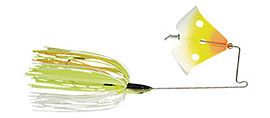All About Bass Fishing - Guide To Fishing Shallow With Topwater
By Rick Seaman and Dan Westfall
 Top water fishing is one of the most exciting ways to catch bass. You can see the strike and often it is spectacular as the bass explodes on the lure. Clear water offers the best opportunity for top water success even though you can catch bass in dingy water with top water lures. Top water action can last all day and is often best on cloudy days.
Top water fishing is one of the most exciting ways to catch bass. You can see the strike and often it is spectacular as the bass explodes on the lure. Clear water offers the best opportunity for top water success even though you can catch bass in dingy water with top water lures. Top water action can last all day and is often best on cloudy days.
 Top water lures come in a variety of actions from slow and quiet to noisy and fast. Experiment to see what type bait and retrieve works best on a given days conditions.
Top water lures come in a variety of actions from slow and quiet to noisy and fast. Experiment to see what type bait and retrieve works best on a given days conditions.
3 Most Important Factors About Fishing Shallow With Topwater
- Top water represents an injured food source that would be easily taken by bass.
- Top water lures draw bass from cover or open water.
- Fast-moving top water baits can attract reaction bites.
3 Most Effective Fishing Methods & Lures
- Use buzzbaits, prop baits or other noisy top water lures in wind and waves.
- Use quiet, still top water lures in calm, clear water – long casts may improve results.
- Proper presentation for ideal lure action is important.
Buzzbaits
A buzzbait is one of the fastest ways to cover shallow water. It makes lots of noise and attracts bass with the commotion it creates. Cast past your target if possible and bring the buzzbait over the top of the cover. Buzzbaits fished across points can pull bass from some distance to chase down the lure. Many times a bass is simply protecting it’s territory when it hits a buzzbait. Water clarity is a major factor in selecting which size and amount of commotion for current conditions. Small and quiet may be a good choice in clear water on a sunny day. Bigger, noisy buzzbaits tend to work better on cloudy days particularly if the water is not real clear.
Practice casting the buzzbait in such a way that you immediately begin reeling as the lure hits the water. This will keep the lure working during the most productive part of the retrieve.
Poppers
Poppers are designed to cast, wait and then pop or gurgle the lure forward for a short distance and stop again. The retrieve can be varied from fast to slow and quiet to noisy. The length of time the lure sits still can often be the key to triggering strikes. Experiment to determine the best retrieve for a given days conditions. Remember that you are trying to imitate something injured on the surface – an easy prey for bass.
Cigar Shaped Topwater Lures
These lures, including Zara Spooks, are designed for “walking the dog” action. This is a side-to-side swimming action created by jerking the rod tip in a sharp pull and pause motion. Slower, softer movement creates a quieter action which may work well in clear water on calm days. Faster action works well on windy days where more noise and action will get attention from bass a farther distance away.
Prop Baits
Prop baits come in a variety of sizes and shapes. Some with props both fore and aft, while others may have one or the other. Work these baits similar to a popper. The noise and attention-getting commotion is created by the rotation of the blades during the retrieve. Experiment with retrieve speed and length of pause.
Floating Worms
Floating worms and snake type baits are ideal for shallow bass, in relatively-clear water. It is a slow way to work shallow water but may be the answer for non-active bass. Use light-weight hooks and no weight to allow the worm to float quietly above or near cover in clear or relatively clear water.
Floating Minnows
Floating minnows, often called stick baits, are usually long and slender with multiple, treble hooks. These lures are designed to float, dive slightly when retrieved, and return to the surface. They are intended to appear as an injured fish struggling. Bass are attracted to these baits as they appear to be easy prey. Pull, jerk or twitch the lure to achieve a variety of actions.
AA Bass Fishing Knowledge Base
- Bass Fishing Overview
- Life Cycle Of Bass
- Seasonal Bass Migration
- Bass Migration - Mid to Late Winter
- Bass Migration - Spring
- Bass Migration - Early Summer
- Bass Migration - Late Summer
- Bass Migration - Fall
- Bass Migration - Early Winter
- Fishing For Bass
- It's Now WHAT You Throw, It's WHERE
- Research The Fishery Before You Go
- Review Contour Maps
- Types Of Cover Used By Bass
- Bass Fishing In Grass Beds
- Bass Fishing In Wood & Timber
- Bass Fishing In Brush & Vegetation
- Establishing Patterns
- Learn To Recognize Bites
- Review Lunar Tables
- Choose The Right Lures
- Find Bass Based On Conditions
- Conditions - Fold Fronts
- Conditions - Wind
- Conditions - Cloudy Days
- Conditions - Fishing In The Rain
- Conditions - Water Clarity
- Conditions - Rising Water
- Conditions - Falling Water
- Conditions - Fishing At Night
- Equipment & Tackle
- Equipment - Fishing Rods
- Equipment - Fishing Reels
- Equipment - Fishing Line
- Equipment - Fishing Lures
- Fishing With Live Bait
- Shallow Water Techniques, 0 -10'
- Shallow Fishing - Spinnerbaits
- Shallow Fishing - Crankbaits
- Shallow Fishing - Top Water
- Shallow Fishing - Pitching & Flipping
- Shallow Fishing - Artificial Worms
- Shallow Fishing - Jigs
- Shallow Fishing - Flukes
- Shallow Fishing - Stick Worms
- Shallow Fishing - Swimbaits
- Fishing Mid Range Depths, 10' - 25'
- Mid Depth - Spinnerbaits
- Mid Depth - Deep Diving Crankbaits
- Mid Depth - Artificial Worms
- Mid Depth - Jigs
- Mid Depth - Swimbaits
- Fishing Deep Water & Structure
- Fishing Deep Water - Jigs
- Fishing Deep Water - Jigging Spoons
- Fishing Deep Water - Artificial Worms
- Planning Your Attack
- Bass Fishing Questions & Answers
- Conservation - Protect The Fishery
Bass information by state
101624
Fishing Information



